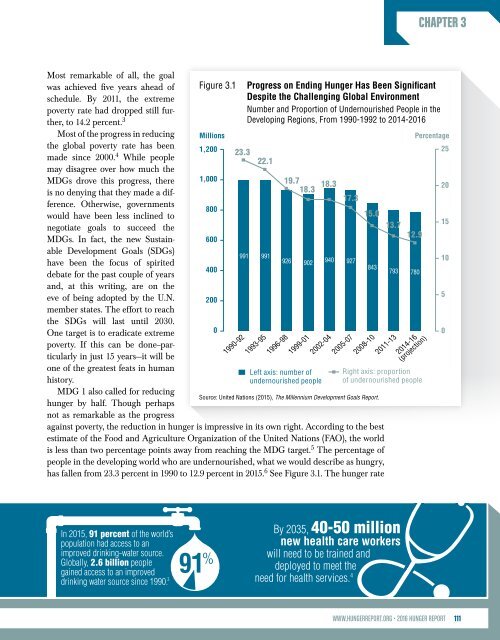THE NOURISHING EFFECT
HR2016-Full-Report-Web
HR2016-Full-Report-Web
You also want an ePaper? Increase the reach of your titles
YUMPU automatically turns print PDFs into web optimized ePapers that Google loves.
CHAPTER 3<br />
Most remarkable of all, the goal<br />
was achieved five years ahead of<br />
schedule. By 2011, the extreme<br />
poverty rate had dropped still further,<br />
to 14.2 percent. 3<br />
Most of the progress in reducing<br />
the global poverty rate has been<br />
made since 2000. 4 While people<br />
may disagree over how much the<br />
MDGs drove this progress, there<br />
is no denying that they made a difference.<br />
Otherwise, governments<br />
would have been less inclined to<br />
negotiate goals to succeed the<br />
MDGs. In fact, the new Sustainable<br />
Development Goals (SDGs)<br />
have been the focus of spirited<br />
debate for the past couple of years<br />
and, at this writing, are on the<br />
eve of being adopted by the U.N.<br />
member states. The effort to reach<br />
the SDGs will last until 2030.<br />
One target is to eradicate extreme<br />
poverty. If this can be done--particularly<br />
in just 15 years—it will be<br />
one of the greatest feats in human<br />
history.<br />
MDG 1 also called for reducing<br />
hunger by half. Though perhaps<br />
not as remarkable as the progress<br />
Figure 3.1<br />
Millions<br />
1,200<br />
1,000<br />
800<br />
600<br />
400<br />
200<br />
0<br />
Progress on Ending Hunger Has Been Significant<br />
Despite the Challenging Global Environment<br />
Number and Proportion of Undernourished People in the<br />
Developing Regions, From 1990-1992 to 2014-2016<br />
Source: United Nations (2015), The Millennium Development Goals Report.<br />
against poverty, the reduction in hunger is impressive in its own right. According to the best<br />
estimate of the Food and Agriculture Organization of the United Nations (FAO), the world<br />
is less than two percentage points away from reaching the MDG target. 5 The percentage of<br />
people in the developing world who are undernourished, what we would describe as hungry,<br />
has fallen from 23.3 percent in 1990 to 12.9 percent in 2015. 6 See Figure 3.1. The hunger rate<br />
23.3<br />
991<br />
1990-92<br />
22.1<br />
991<br />
1993-95<br />
1996-98<br />
19.7<br />
18.3 18.3 17.3<br />
926 902<br />
1999-01<br />
Left axis: number of<br />
undernourished people<br />
2002-04<br />
940 927<br />
2005-07<br />
15.0<br />
843<br />
2008-10<br />
13.7<br />
2011-13<br />
12.9<br />
793 780<br />
Percentage<br />
2014-16<br />
(projection)<br />
Right axis: proportion<br />
of undernourished people<br />
25<br />
20<br />
15<br />
10<br />
5<br />
0<br />
In 2015, 91 percent of the world’s<br />
population had access to an<br />
improved drinking-water source.<br />
Globally, 2.6 billion people<br />
gained access to an improved<br />
drinking water source since 1990. 3<br />
By 2035, 40-50 million<br />
new health care workers<br />
will need to be trained and<br />
deployed to meet the<br />
need for health services. 4<br />
WWW.HUNGERREPORT.ORG • 2016 HUNGER REPORT 111


